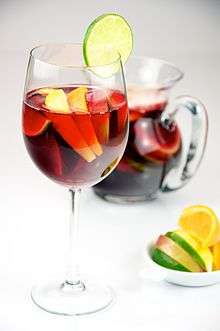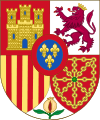Sangria
Sangria (English: /sæŋˈɡriːə/,Spanish: sangría [saŋˈɡɾi.a]); Portuguese pronunciation: [sɐ̃ˈɡɾi.ɐ] is an alcoholic beverage originating in Spain and Portugal. Under EU regulations[1] only those two Iberian nations can label their product as Sangria; similar products from different regions are differentiated in name.
| Look up sangria in Wiktionary, the free dictionary. |
 | |
| Course | Drink |
|---|---|
| Place of origin | Spain and Portugal |
| Serving temperature | Cold or chilled |
| Main ingredients | Red wine and Fruit |
A punch, sangria traditionally consists of red wine and chopped fruit, often with other ingredients or spirits.
Sangria is one of the most popular drinks in Spanish cuisine. It is commonly served in bars, restaurants, and chiringuitos, and at festivities throughout Portugal and Spain.[2]
History and etymology
Sangría literally means bloodletting in Spanish.[3] The term sangria used for the drink can be traced back to the 18th century. According to the SAGE Encyclopedia of Alcohol, sangria's origins "cannot be pinpointed exactly, but early versions were popular in Spain, Greece, and England."[4][5]
Sangaree, a predecessor drink to sangria that was served either hot or cold, likely originated in the Caribbean (West Indies),[6][7] and from there was introduced to mainland America, where it was common beginning in the American colonial era but "largely disappeared in the United States" by the early twentieth century.[6] Sangria as an iced drink was reintroduced to the U.S. by the late 1940s through Hispanic Americans and Spanish restaurants,[6] and enjoyed greater popularity with the 1964 World's Fair in New York.[5][6]
Recipe
.jpg)
Sangria recipes vary wildly even within Spain, with many regional distinctions.[8] The base ingredients are always red wine, and some means to add a fruity or sweeter flavour, and maybe boost the alcohol content.
Traditionally may be mixed with local fruits such as peaches, nectarines, berries, apples, pears, or global fruits such as pineapple or lime,[8] and sweetened with sugar and orange juice.[9][10] Spanish Rioja red wine is traditional.[11][12] Some sangria recipes, in addition to wine and fruit, feature additional ingredients, such as brandy, sparkling water, or a flavored liqueur.[8]
Sangria blanca (sangria with white wine) is a more recent innovation.[13][14] For sangria blanca, Casas recommends dry white wines such as a Rueda, Jumilla, or Valdepeñas.[15]
Ponche de Sangria is a variation for children, often for birthday parties.[16] Oranges, peaches, and other sugary fruits are combined with berries, grapes, or food coloring in order to create the coloration of sangria.[17] A soft drink typically replaces the wine.
European Union law protection
Under European Union law, the use of sangria in commercial or trade labeling is now restricted under geographical labeling rules.
The European Parliament approved new labeling laws by a wide margin in January 2014, protecting indications for aromatized drinks, including sangria, Vermouth and Glühwein. Only sangria made in Spain and Portugal is allowed to be sold as "sangria" in the EU; sangria made elsewhere must be labeled as such (e.g., as "German sangria" or "Swedish sangria").[18]
The definition of sangria under European Union law from the 2014 Regulation states that it is an:
Aromatised wine-based drink
—which is obtained from wine,
—which is aromatised with the addition of natural citrus-fruit extracts or essences, with or without the juice of such fruit,
—to which spices may have been added,
—to which carbon dioxide may have been added,
—which has not been coloured,
—which have an actual alcoholic strength by volume of not less than 4,5 % vol., and less than 12 % vol., and
—which may contain solid particles of citrus-fruit pulp or peel and its colour must come exclusively from the raw materials used.‘Sangría’ or ‘Sangria’ may be used as a sales denomination only when the product is produced in Spain or Portugal. When the product is produced in other Member States, ‘Sangría’ or ‘Sangria’ may only be used to supplement the sales denomination ‘aromatised wine-based drink’, provided that it is accompanied by the words: ‘produced in …’, followed by the name of the Member State of production or of a more restricted region.
The 2014 Regulation also recognises Clarea as an aromatised wine-based drink, which is obtained from white wine under the same conditions as for Sangría. ‘Clarea’ may be used as a sales denomination only when the product is produced in Spain. When the product is produced in other Member States, ‘Clarea’ may only be used to supplement the sales denomination ‘aromatised wine-based drink’, provided that it is accompanied by the words: ‘produced in …’, followed by the name of the Member State of production or of a more restricted region.
See also
- Tinto de Verano
- Spanish cuisine
- Mulled wine
- Spritzer
References
- "Where is Sangria originally from?". nativespanishtapas.com. 2018-05-22. Retrieved 2020-05-27.
- Penelope Casas, 1,000 Spanish Recipes (Houghton Mifflin Harcourt, 2014), p. 669.
- ASALE, RAE-. "sangría". «Diccionario de la lengua española» - Edición del Tricentenario (in Spanish). Retrieved 2019-11-03.
- Anne Lindsay Greer, Cuisine of the American Southwest (Gulf, 1995), p. 72.
- Wylene Rholetter, "Sangria" in The SAGE Encyclopedia of Alcohol: Social, Cultural, and Historical Perspectives (ed. Scott C. Martin: SAGE Publications, 2014).
- Smith, p. 522.
- John Ayto, The Glutton's Glossary: A Dictionary of Food and Drink Terms (Routledge, 1990), p. 259.
- Hellmich, p. 6.
- Casas, p. 669: "The main ingredients are a robust, not-too-expensive wed wine, fruit, sugar, and gaseosa (a mildly sweet seltzer).
- Smith, p. 522: "Sangria is traditionally ... sweetened with a little sugar, and flavored with orange juice."
- Hellmich, p. 9: "For authenticity, look for a Spanish red Rioja. Sangrias are traditionally made with a juicy, light red wine such as a Rioja Cosecha, or a medium-bodied dry wine, such as a Rioja Reserva."
- Smith, p. 522: "Sangria is traditionally made with a full-bodied red wine (such as a Spanish rioja)."
- Hellmich, p. 32: "Sangria Blanca (White Wine Sangrias): "White wine sangrias are not as steeped in tradition as those made with red wine, nor are they as common..."
- Smith, p. 522: "White sangria is an innovation made using white wine."
- Casas, p. 669.
- De Vito. Seasonal Sangria: 101 Delicious Recipes to Enjoy All Year Long!. Cider Mill Press. p. 194.
- "Ponche de Sangria: Super Simple Non-alcoholic Sangria for Kids". cupcakesandcutlery.com. Retrieved August 1, 2020.
- "EU: True sangria wine comes from Spain, Portugal". Associated Press. January 14, 2014.
- Zahn, Lindsey A. "European Parliament Passes Stricter Legislation for Labeling Sangria Wines". Winelawonreserve. On Reserve: A Wine Law Blog. Retrieved 18 May 2015.
- "COUNCIL REGULATION (EEC) No 1601/91 of 10 June 1991". Official Journal of the European Communities. 10 June 1991.
Works cited
- Mittie Hellmich, Sangria: Fun and Festive Recipes, Chronicle Books, 2004, ISBN 978-0811842907
- Andrew F. Smith, "Sangria" in The Oxford Companion to American Food and Drink (ed. Andrew F. Smith: Oxford University Press, 2007), p. 522.
